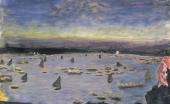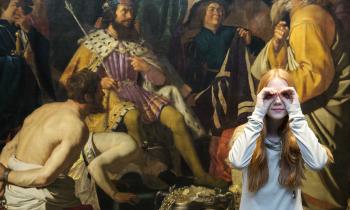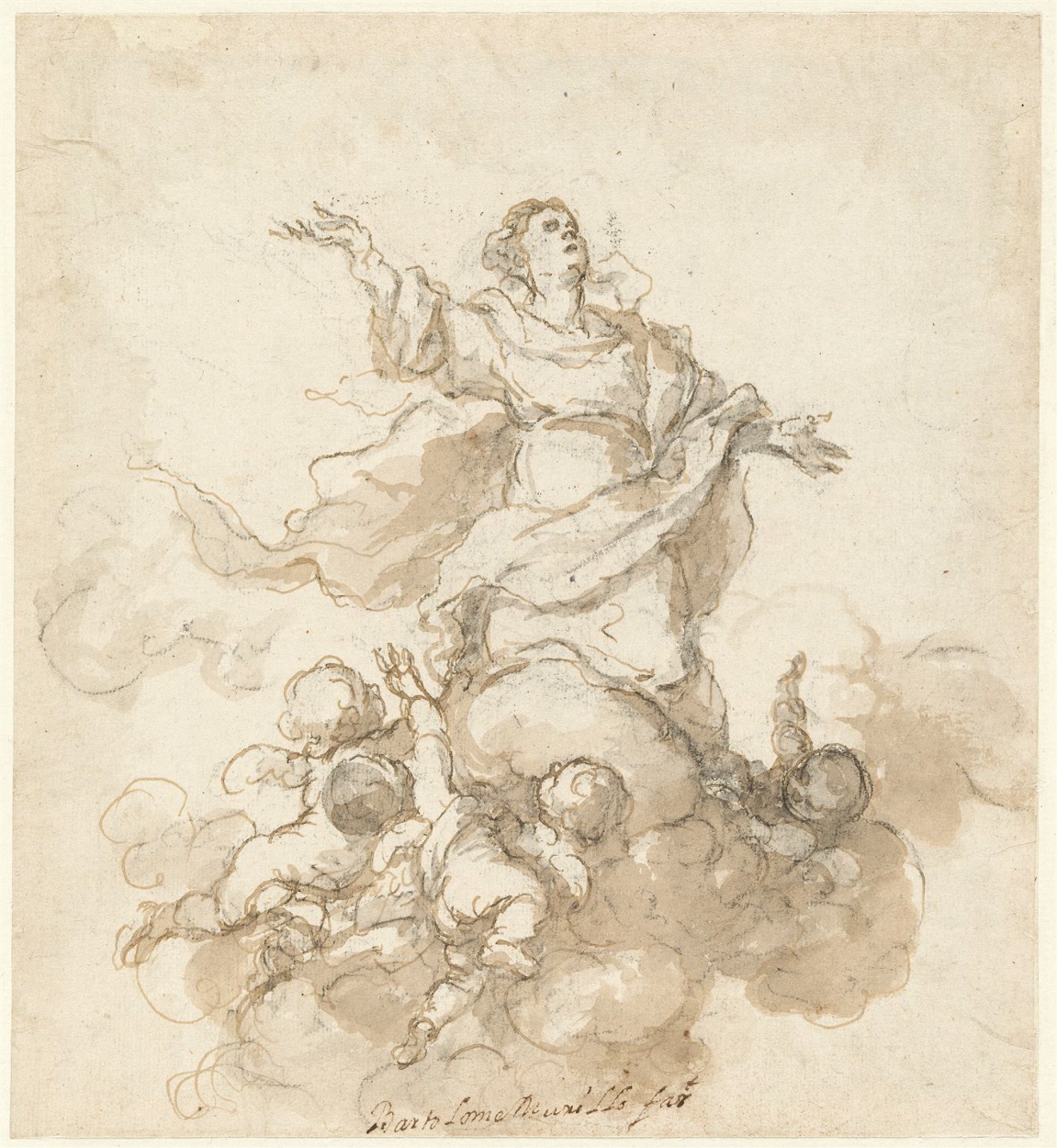Bartolomé Esteban Murillo
Bartolomé Esteban Murillo
This is one of Bartolomé Esteban Murillo's most highly praised drawings, due to its spectacular, free, and expressive use of black pencil and its transparent washes, as well as the vibrant touches of pen that define the forms of the figures and clothing. First published by August Mayer (1918), it was related by Jonathan Brown (1976 and 2012) to the one sold by Christie's of London in 1840. There, it is listed as belonging to the collection of the Baron of St. Helens, British ambassador to Spain during the late eighteenth century and owner of an important collection of drawings by this artist. However, the drawing sold in obsidian at the Museum of Fine Arts in Houston (inv. 94.1145) at that time is described by Christie's as “The Assumption of the Virgin, with Angels, in pen; a sketch on the reverse. That does not tally with the technique employed in the present drawing, in which the use of washes is more complex. Nor is there any sketch on the back (Mena Marqués 2014). Mayer (1934) and Alfonso Pérez Sánchez (1970) consider it a preparatory drawing for Assumption of the Virgin, a canvas at the Hermitage Museum in Saint Petersburg (inv. GE 387), which is the only known version of this subject by Murillo and dates from his final decade of artistic activity. However, Brown (1976, 2012) and Diego Angulo Íñiguez (1981) reject that idea based on the profound compositional art differences. Most notably, the canvas has the characteristic vertical format of altar paintings, while the square format of the drawing indicates it may have been intended to crown an altarpiece. The Virgin's position is also quite different. In the Russian canvas, she stands with her weight resting on her left knee over the clouds, turning her head and body toward the left of the composition. In the drawing, however, she faces the viewer, with raised, open arms, kneeling on the clouds with her torso and head turned to the right.
This iconography also appeared in another work, now lost, that was painted on stone. It is listed in the inventory of the collection of Canon Justino de Neve, Murillo's patron and friend. That work may have dated from the mid-1660s, when the artist was involved in various important commissions for Neve.[1] This drawing may have been a preparatory work for that lost composition, as its technical characteristics and handling of certain anatomical details, such as the abbreviated facial features or the cherubs' arms, correspond to Murillo drawings from around 1665. Moreover, the British Museum in London has a drawing (inv. 1895, 0915.888) identical to the one presented here, except for the head, which faces the other way. Previously attributed to Murillo, it is now listed as anonymous. That sketch may have been a copy of a first pen drawing by Murillo for the same composition as the Hamburg drawing - possibly the lost Assumption painted for Neve. The lower part of the English drawing also has two cherubs flving with a phylactery that are similar to an image at the top of Murillo's Nativity drawing at the Metropolitan Museum of New York (inv. 1995.1143). The latter composition varies only slightly from a related Nativity in obsidian at the Museum of Fine Arts in Houston (inv. 94.1145) that dates between 1665 and 1670. That Nativity is grouped with two other small paintings on the same material that also appear in Neve's inventory:[2] Christ on the Mount of Olives and Christ Bound to a Column with Saint Peter. Following the canon's death in 1685, the Assumption from this group, also in stone, was acquired by Juan Salvado Navarro, a surgeon from Seville. The drawing at the British Museum is thus a copy of Murillo's version for an Assumption unlike Nativity from that same group. This seems to indicate that both scenes were still being painted when the copyist had access to Murillo's preparatory drawings. On the other hand, the idea expressed in the Hamburg drawing appears to correspond to a painting with a different format. It would have been smaller than an altar painting, like the composition in stone for Neve, with the Virgin and the cherubs floating in a broad and luminous empty space that would have contrasted with the dark backgrounds of the three more dramatic scenes in obsidian.
Manuela B. Mena Marqués
1 Jordan 2002, 71 and 196, no. 62.
2 Finaldi (dir.) 2012, 130-35, nos. 13-15.
Details zu diesem Werk
Beschriftung
Provenienz
[José Atanasio Echeverría]; Julian Benjamin Williams, Seville (d. 1866); John Wetherell (?) (d. 1865); Horatio/Nathan Wetherell (?) (until 1874); Frederick William Cosens, London (from 1874 to 1890); Sotheby's, London, auction of the property of Frederick William Cosens (from November 11 to 21, 1890); Bernard Quaritch Ltd., London (from November 1890 to July 1891); acquired by the Hamburger Kunsthalle (July 14, 1891).
Bibliographie
Kunst aus acht Jahrhunderten, hrsg. von Hamburger Kunsthalle und Freunde der Kunsthalle e.V., Hamburg 2016, S.299, Abb.
Jens Hoffmann-Samland, with contributions by María Cruz de Carlos Varona, Gabriele Finaldi, José Manuel Matilla u. a.: The Spanish Gesture. Drawings from Murillo to Goya in the Hamburger Kunsthalle, Madrid 2014, S.88-89, Abb., 225, Nr.112
Manuela B. Mena Marqués: Bartolomé Esteban Murillo (1617-1682) Catálogo razonado de los dibujos, Santander: Fundación Botín 2014, Nr.44
Jonathan Brown: Murillo: Virtuoso Draftsman, New Haven: Yale University Press; Madrid: Centro de Estudios Europa Hispánica 2012, S.118-119, Nr.33
Peter Cherry: Murillo's Drawing Academy, in Suzanne L. Stratton-Pruitt (dir.), Bartolomé Esteban Murillo (1617-1682); Paintings from American Collections (exh. cat.) New York: Harry N. Abrams; Fort Worth: Kimbell Art Museum, 2002,47-61, S.194, Nr.75, 88
Alfonso Emilio Pérez Sánchez: Tres siglos de dibujo sevillano, Ausst.-Kat. Hospital de los Venerables, Sevilla 1995, S.35 und 208-9, Nr.87
Alfonso E. Pérez Sánchez: Historia del dibujo en España de la Edad Media a Goya, Madrid: Cátedra 1986, S.283
Claudie Ressort: Murillo dans les musées français, Paris: Réunion des Musées Nationaux 1983, S.40
Manuela B. Mena Marqués: Bartolomé Esteban Murillo (1617-1682), Madrid: Ministerio de Cultura, Fundación Juan March; London Royal Academy of Arts 1982, S.204, Nr.D7
Diego Angulo Íñiguez: Murillo: su vida, su arte, su obra. 3 vols. (vol. 1: Su vida, su arte, su obra; vol. 2: Catálogo crítico,; vol. 3: Láminas), Madrid: Espasa-Calpe 1981, S.2:392
Pérez Sánchez: El dibujo español de los Siglos de Oro, Ausst.-Kat. Ministerio de Cultura, Dirección General del Patrimonio Artístico, Archivos y Museos, Madrid 1980, S.88, Nr.178
Jonathan Brown: Murillo & his Drawings, Princeton, New Jersey 1976, S.112-113, Nr.34
Alfonso E. Pérez Sánchez: Gli spagnoli da El Greco a Goya (Disegni dei Maestri), Mailand, Fabbri 1970, S.85
Louise S. Richards: Bartolomé Esteban Murillo: A Drawing Study for a Virgin and Child, in: Bulletin of Cleveland Museum of Art, 55, 1968, , S.238
Wolf Stubbe: Spanische Zeichnungen von El Greco bis Goya, Ausst.-Kat. Hamburger Kunsthalle 1966, S.22, Nr.164, l.46
Diego Angulo Íñiguez: Murillo: Varios dibujos de la 'Concepción' y de 'Santo Tomás de Villanueva' ", Archivo Español de Arte, 25, 1962, S.234-236
José Gómez Sicre: Spanish Drawings, XV-XIX Centuries, hrsg. von Tana de Gámez Losada, New York, Hyperion Press 1949
Erwin Gradmann: Spanische Meisterzeichnungen, Frankfurt, Prestel 1939, Nr.15
August Liebmann Mayer: Anotaciones a obras murillescas, in: Boletín de la Sociedad Española de Excursiones, 42 1934, , S.14-18
August Liebmann Mayer: Die Spanischen Handzeichnungen in der Hamburger Kunsthalle zu Hamburg, in: Zeitschrift für die bildenden Kunst 53, 29 1918, , S.112








